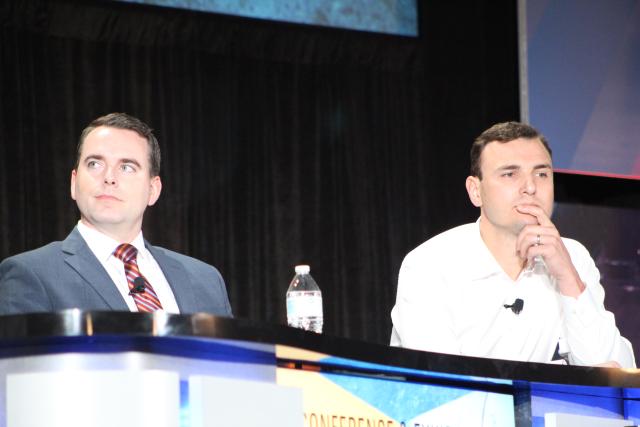
Nathaniel Harding, founder and president of Antioch Energy LLC (left), and Will Ulrich, co-CEO of Presidio Petroleum LLC, participate in the private operators panel and DUG Midcontinent in Oklahoma City. (Source: Mary Holcomb, Hart Energy)
OKLAHOMA CITY—The Midcontinent confirms two rules of the exploration and production business:
- Every pay zone’s different; and
- The best place to find oil and gas is where it’s already been found.
Two executives who head privately held Oklahoma upstream players emphasized those points in a panel discussion at Hart Energy’s recently held DUG Midcontinent conference and exhibition.
The western half of the Sooner State may get more publicity but there’s great potential on the state’s eastern side, Nathaniel Harding, founder and president of Antioch Energy LLC, told conference attendees.
“There is a tremendous recoverable resource here,” Harding said of his firm’s 24,000 net acres, “a large, quality position,” in Hughes County, Okla., that is “scalable, stacked and saturated.” Its wells target the liquids-rich Arkoma Stack, a play he rated “world class.”
Antioch targets three resources plays, the Caney, Mayes and Woodford that, combined, can offer 500 ft of potential pay. Wells with two-mile laterals cost some $4 million to $6 million with “fewer failure scenarios,” Harding said.
“We’re shallow… we have low decline rates and we have optionality between markets,” with direct access to both the Cushing, Okla., oil hub and Gulf Coast markets through “good midstream assets,” Harding noted. Residue gas also enjoys optionality, he said. “It’s a classic case of finding oil and gas where it’s been found before,” Harding added, noting eastern Oklahoma has produced hydrocarbons for more than a hundred years.
And like the rest of the Oklahoma energy industry, Antioch works within a comparatively friendly regulatory and community support environment, he said.
“It’s a nice place to be with the macro trends coming down the pike,” Harding added.
Will Ulrich, co-CEO of Presidio Petroleum LLC, began his presentation with a broad review of the oil and gas industry’s current challenges—those macro trends Harding noted—with investors and the public. Presidio is the second-largest producer in the Western Anadarko Basin, which extends from northwestern Oklahoma into a corner of the Texas Panhandle, he said.
He quoted Pioneer Natural Resources, which Ulrich rated “a super-efficient company,” had a 9% return on capital employed (ROCE) last year—up from a 4% ROCE in 2017.
He compared that result to Google, Disney and Apple that reported ROCEs of 16%, 18% and 28%, respectively, in 2018.
“We have a return problem,” he said of the industry, and that explains why investors have walked away for oil and gas.
Given the current business climate, “Presidio Petroleum is uniquely positioned to navigate today’s energy environment,” Ulrich said. As a “21st Century start-up,” Presidio emphasizes contrarian thinking, values systems over goals and is technologically savvy. But he noted “every [E&P] company is now a tech company” as producers incorporate big data and work to find the best ways to employ it to cut costs and increase production. It targets “to operate and acquire out-of-favor, developed assets.”
Contrarian thinking includes seeking attractive opportunities in the well-established Anadarko that currently are out of favor. “We want to be in dry gas, that makes a lot of sense” for long-term potential, Ulrich said in response to an audience question.
He said technology “empowers employees at all levels to take ownership and innovate, provides an intense focus on measurement that gives everyone—from the pumper to the CEO—the information and responsibility to drive ownership and maximize profitability.
“If the software and hardware don’t exist to let us do our job, we will create it,” Ulrich added.
For 2020, the firm has targeted a potential $1 billion in acquisitions by employing “a simple, virtuous cycle” that moves from acquisition, to optimization, to enhancement, to optimization of the firm’s capital structure.
Recommended Reading
Goodbye Manual Control: Vital Energy’s Automation Program Boosts Production
2024-07-12 - Production, ESP efficiency soared when the company automated decisions with AI at the edge.
E&P Highlights: Sept. 16, 2024
2024-09-16 - Here’s a roundup of the latest E&P headlines, with an update on Hurricane Francine and a major contract between Saipem and QatarEnergy.
E&P Highlights: July 15, 2024
2024-07-15 - Here’s a roundup of the latest E&P headlines, including Freeport LNG’s restart after Hurricane Beryl and ADNOC’s deployment of AI-powered tech at its offshore fields.
Tech Trends, URTeC Edition: Unconventional Solutions for Unconventional Resources
2024-07-16 - In this month’s Tech Trends, which takes place at the 2024 Unconventional Resources Technology Conference, new technologies are on display that ensure both efficient and sustainable operations.
Where, When and How to Refrac—Weighing All the Options
2024-07-12 - Experts weigh in on strategic considerations when deciding how to rejuvenate production from a tired well.
Comments
Add new comment
This conversation is moderated according to Hart Energy community rules. Please read the rules before joining the discussion. If you’re experiencing any technical problems, please contact our customer care team.





